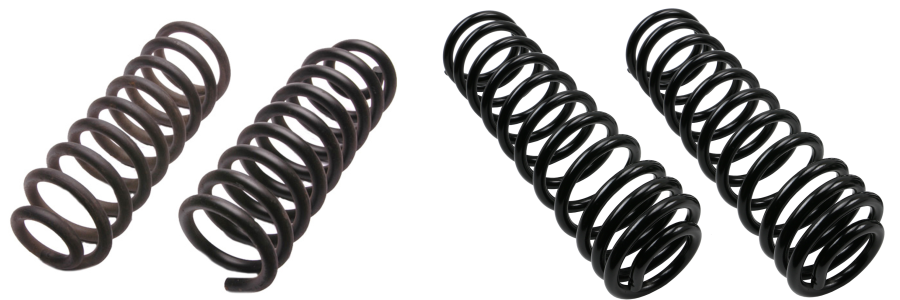
The 1983-1997 Ford Ranger 4×4 came with a Twin Traction Beam (TTB) front suspension that used coil springs. The majority of people that lift these trucks do so by buying a complete aftermarket suspension kit. But then there’s those that either modify those kits or completely build their own suspension setup. If you’re modifying your suspension and need help with your coil springs, this page will hopefully help you.
Coil Spring Basics
I have seen people use coil springs made for Ford F-150’s, Bronco’s, early Bronco’s, Explorers, and Jeep Cherokees in their Ford Ranger and Bronco II. The issues to take into consideration are:
- Outside Spring Diameter (It might not fit in the upper bucket)
- Coil Spring End Type (You may need a different spring retainer at the axle) (See next section)
- Spring Rate (It may be too soft or too stiff for your application)
The chart below shows how these springs differ from one another.
| Vehicle | Spring O.D. | Spring Rate | Wire Dia. |
| 1983-1997 Ford Ranger | 4.840″ | 430-485 lb/in | 0.670″ |
| 1991-1994 Ford Explorer | 4.990″ | 485 lb/in | 0.680″ |
| 1984-1990 Ford Bronco II | 4.750″ | 369 lb/in | 0.625″ |
| 1980-1996 F-150/Bronco | 5.440″ | 366 lb/in | 0.710″ |
| 1977-1979 F-150/Bronco | 5.460″ | 383 lb/in | 0.710″ |
| 1966-1977 Ford Bronco | 5.250″ | 245 lb/in | 0.625″ |
| 1984-1996 Jeep Cherokee | 5.200″ | 146 lb/in | 0.570″ |
Coil Spring End Types
Not all coil springs have the same end types and require different spring mounts. There are three basic end types used:
- Tangential (TG) – Where the end of the coil continues to twist off into space.
- Square (SQ) – The last coil bends back down to touch the coil below it.
- Pigtail (PT) – The last coil of the spring is the square type but has a much smaller diameter than the coils in the body of the spring.
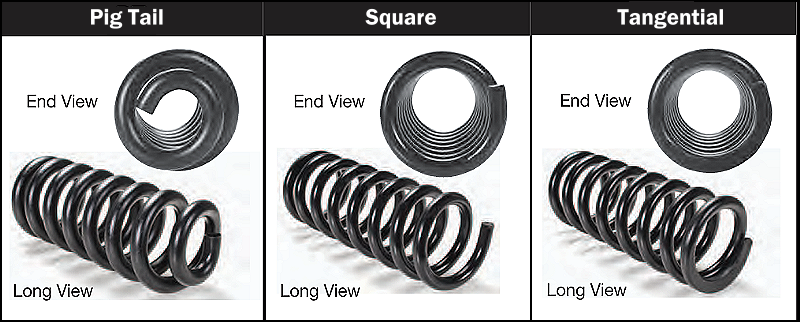
| Vehicle | End Type |
| 1983-1997 Ford Ranger | SQ/PT |
| 1991-1994 Ford Explorer | SQ/PT |
| 1984-1990 Ford Bronco II | SQ/PT |
| 1980-1996 F-150/Bronco | PT/PT |
| 1977-1979 F-150/Bronco | TG/PT |
| 1966-1977 Ford Bronco | TG/PT |
| 1984-1996 Jeep Cherokee | TG/PT |
If you’re mounting early Ford Bronco or Jeep coil springs with a tangential coil end to a Dana 35 TTB, you should look at our page on Mounting Early Bronco Coils To Your Dana 35 TTB.
What Is Spring Rate (lb/in)?
Spring Rate is the amount of weight required to deflect a spring one inch (lb/in). The lower the Spring Rate, the softer the spring. The softer the spring, the smoother the ride and the more the spring flexes. However, too soft of a spring could create excessive body roll and seriously decrease its handling on the road. A higher spring rate is going to have a stiffer ride and less body roll on the highway.
What Is Load Rate?
Linear Rate & Progressive Spring Rates
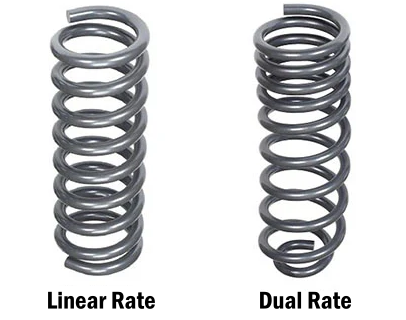
Linear Rate: Stock Ford Ranger springs are linear rate springs. Many of the larger suspension manufacturers use Linear Rate Springs. Linear springs cost less, are simpler to design, simpler to inspect and provide fairly consistent ride heights. To put it simply, linear spring rate means that it has a constant rate from the top to the bottom of the spring. For instance, if we have a 300lb/in linear rate spring that is 12 inches long, it will take approximately 300lb to deflect it 1 inch. The next inch of deflection will take another 300lb of load, and the next inch of deflection will take an additional 300# of load (and so on until the spring goes solid). At this point, there will be 900lb of load on a 12-inch long spring that has now been compressed to a 9” spring height.
Progressive Rate: “Progressive rate springs” are generally classified into two sub-types:
1) Constantly increasing rate springs.
The first type (constantly increasing rate) of springs is most often used as “load-compensating springs” on the rear of a vehicle when the vehicle will often see significant load changes in the cargo area.
2) A “dual-rate” spring with two linear rates connected with a rate-transition range.
The second type of progressive rate suspension spring, the dual rate spring with two linear rates connected with a rate transition range, is a much more sophisticated suspension spring. These springs are easily identified by having a few closely wound coils at one end and then wider, equal-spaced coils at the other end. They have rates described as 200/425lb/in. This means that the spring has an initial rate of 225lb/in through some range of deflection, and then the rate transitions to 425lb/in through a deflection range of 1”-1.5.” The big advantage of these springs is that they can provide “roll control” in addition to roll control provided by sway bars.
James Duff uses a progressive rate (dual rate) coil spring in their suspension kits. According to James Duffs website: ‘Our progressive coil rate increases as the coil compresses. The upper wraps are softer for a more comfortable street ride; the lower rates are firmer to handle bumps and dips without jarring and bottoming out. The progressive nature of the spring also allows for better and more predictable handling by helping keep the vehicle flatter in the corners and limiting body lean.’
Dual rate coil springs are typically used in vehicle suspension systems that need to provide a comfortable ride under normal driving conditions, but also need to be able to handle higher loads or more extreme driving conditions. The dual rate design allows the spring to provide a comfortable ride when it is not heavily loaded, but to stiffen up when the vehicle encounters heavier loads or more extreme conditions.
Why Does The Bronco & F-150 Coils Lift Give Me More Lift?
To understand this, we need to know the relaxed length of the Ford Ranger, F-150, and Bronco coil springs:
| Vehicle | Relaxed Spring Length | Taller+ |
| 1983-1996 Ford Ranger | 13.75″ | 0 |
| 1980-1996 Ford F-150 | 16.19″ | 2.44″ |
| 1980-1996 Ford Bronco | 16.19″ | 2.44″ |
| 1975-1979 Ford F-150 | 15.94″ | 2.19″ |
| 1978-1979 Ford Bronco | 15.94″ | 2.19″ |
| 1966-1977 Ford Bronco | 16.31″ | 2.56″ |
Looking at that chart, you can see that a stock 1980-1996 Ford F-150 is 2.44 inches taller than the stock Ford Ranger coil spring. So, you can see right away that a stock F-150 coil is going to give your Ranger some lift over the stock Ford Ranger coil. But how much?
The critical things to know are the sprung weight of your vehicle, the spring rate of the coil, and the free length of the coil spring. Scroll down this page to find out how to weigh your vehicle to calculate the right sprung weight to use as well as how to measure a coil spring to find its spring rate.
I’ll use my Ranger for this example. My Ranger has a steel winch bumper, winch, and steel cage in the bed, so my truck is going to be heavier than a stock Ranger. With my 1,271 pounds sprung weight:
1,271 ÷ 366 lb/in (F-150 Coil) = 3.47 inches (16.19″ – 3.47″ = 12.72″)
Normal ride height for a Ford Ranger is 10.50 inches. 12.72″ – 10.50″ = 2.22 Inches of lift
If my sprung weight was 100 lbs less (1,171), then the coil would only compress by 3.19 inches, and I would gain .28 inches of lift. So, the new expected lift would be 2.50 inches.
So, with this in mind, a coil designed to lift an F-150 4-inches is probably going to give you more than that, but you’ll have to get its free length and spring rate and use our calculator to see how much it’s going to compress.
Is The F-150 Coil Stiffer?
When people have asked about using an F-150 coil I’ve seen people reply that it was going to be a harsher ride because the F-150 has a higher spring rate because it’s designed for a heavier vehicle. The F-150 spring rate is actually lower than the Ranger. That extra 2.44 inches in length gives it a higher load rating over the Ranger coil. Here’s two examples to show what I mean:
- 1996 Ford Ranger = 1,323 lbs Load Rate / 377 lb/in Spring Rate / 16.19 inches
- 1985 Ford F-150 = 1,428 lbs Load Rate / 366 lb/in Spring Rate / 13.75 inches
While the F-150 may have a lower spring rate, the longer length gives it a higher load rate to support the weight of the heavier truck.
Below is a photo of a Ford F-150 coil spring next to a Bronco II spring (similar to a Ranger spring). You can see that they have a similar design and even the same number of coils, but the wire on the F-150 coil (left) is slightly larger, the coil is slightly wider, and obviously taller. While they’re not far off in spring rates, the taller spring of the F-150 has a higher load rate.
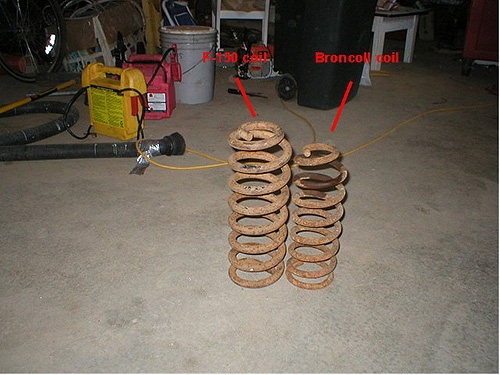
Remember, the load rate typically refers to the relationship between the force a spring can handle and the weight (or load) it supports. It’s more concerned with the amount of load or weight that a spring is designed to support without being overstressed or deformed. The load rate doesn’t affect the ride quality.
NOTE: F-150 and Bronco coil spring are a little wider than a Ranger spring, so you normally have to modify the upper coil bucket for them to fit.
Using 1966-1977 Early Ford Bronco Springs
When using coil springs other than those intended for a Ranger, the Early Bronco coil springs seem to be the better option. Especially if you’re looking for a softer spring. A stock Early Bronco coil spring is 16.37 inches long which is 2.56 inches longer than the 13.75-inch Ranger spring. The outside diameter is 5.25 inches making it only approximately 0.25 inches larger in diameter than the Ranger spring, and a good aftermarket lift spring will have a spring rate in the 300 – 360 lb/in range. One downside is that the Bronco has a tangential coil end, so they won’t bolt in like a F-150 or Bronco coil spring will.
If you’re mounting early Ford Bronco coil springs with a tangential coil end to a Dana 35 TTB, you should look at our page on Mounting Early Bronco Coils To Your Dana 35 TTB.
Using Jeep Cherokee Coil Springs
I’ve seen and heard of people swapping in Jeep XJ (Cherokee) coil springs into a Ford Bronco II and Ranger for a super flexy suspension. While this may be ok for off-road use, I would not drive it on the street.
The Jeep coil is 4.65 inches taller than the Bronco II / Ranger coils but has a much lower spring rate and load rate that the Bronco II and Ranger springs. Their longer length and lower spring rate are going to make them more flexible and offer more travel, but they’re not rated to support the weight of a Ranger, and they’re going to make the vehicle unstable on the road. I would not recommend them on the street.
Jeep springs have a tangential coil end, so they won’t bolt in like a F-150 or Bronco coil spring will.
If you’re mounting Jeep coil springs with a tangential coil end to a Dana 35 TTB, you should look at our page on Mounting Early Bronco Coils To Your Dana 35 TTB. The Bronco uses a coil spring with the same end types.
| Vehicle | Relaxed Spring Height | Spring Rate | Load Rate |
| Ford Ranger | 13.75″ | 430 – 485 lb/in | 1447 lb |
| Ford Bronco II | 13.75″ | 337 – 369 lb/in | 1200 lb |
| Jeep Cherokee | 18.40″ | 146 lb/in | 503 lb |
1983-1997 Ford Ranger Spring Rates
I looked at the Moog Website and looked up coil springs for various years just to compare them. This is what I found:
| Year | Engine | Wheelbase | Spring Rate |
| 1988 | 2.9L | 108″ / 114″ | 377 lb/in |
| 1992 | 2.3L | 108″ | 377 lb/in |
| 1992 | 2.9L | 108″ | 430 lb/in |
| 1992 | 3.0/ 4.0L | 108″ | 430 lb/in |
| 1993 | 2.3L | 108″ | 377 lb/in |
| 1993 | 3.0/4.0L | 108″ | 377 lb/in (no a/c) |
| 1993 | 3.0/4.0L | 108″ | 430 lb/in (a/c) |
| 1993 | 3.0/4.0L | 125″ | 485 lb/in |
| 1996 | 3.0/4.0L | 108″ | 377 lb/in (no a/c) |
| 1996 | 3.0/4.0L | 108″ | 430 lb/in (a/c) |
| 1996 | 3.0/4.0L | 125″ | 485 lb/in |
Findings:
- The 1980’s models all seemed to have a 377 lb/in spring rate.
- 1992 seemed to have either a 377 lb/in or 430 lb/in spring rate.
- 1993-1997 seemed to have a 377 lb/in for Rangers without air conditioning, 430 lb/in for Rangers with air conditioning, and 485 lb/in for Super Cabs.
- All Rangers had a coil spring with a relaxed length of 13.75-inches and a compressed length of 10.50-inches.
Coil Spring Specifications Chart
Here is a list of various coil springs available for the Ford Ranger, F-150, Bronco, Jeep Cherokee and their specifications.
- EB = 1966-1977 Early Ford Broncos
- DR = Dual Rate coil springs
- Spring Rate = lb/in
| Coils | Part # | Spring Rate | Free Length |
| Stock Ranger Coil | 485 | 13.75″ | |
| Skyjacker Ranger Level Coils | 132 | 445 | 14.3125″ |
| Skyjacker Ranger Level Coils | 132x | 397 | 15.50″ |
| Skyjacker Ranger 4” lift coils | 134 | 480 | 17″ |
| Skyjacker Ranger 6” lift coils | 136 | 435 | 18.875″ |
| Skyjacker Ranger 8” lift coils | 138 | 430 | 21″ |
| Skyjacker Jeep Cherokee Coils 6” | JC60F | 230 | 22″ |
| Skyjacker Jeep Cherokee Coils 8” | JC80F | 235 | 23″ |
| Skyjacker Jeep Wrangler Coil 6” | TJ60F | 180 | 22″ |
| Skyjacker Jeep Wrangler Coil 8” | TJ80F | 227 | 22.50″ |
| Skyjacker 80-96 F150 6” Lift | 186 | 623 | 20.125″ |
| Skyjacker 80-96 F150 8” Lift | 188 | 560 | 22.25″ |
| Skyjacker 79 F150 2” lift | 172 | 330 / 400 DR | 18″ |
| Skyjacker 79 F150 4” lift | 174 | 525 | 19.50″ |
| Skyjacker 79 F150 6” lift | 176 | 452 | 21″ |
| Skyjacker 79 F150 9” lift | 179 | 550 | 23″ |
| Rough Country Ranger Leveling Coils | 9264-4 | 445 | 14.125″ |
| Rough Country Ranger 4” lift | 9261 | 435 | 14.125″ |
| BDS 6” Ranger Coil | 033602 | 400 | 20″ |
| James Duff Ranger 5.5″ Lift | 5106 | 385 / 650 DR | 18.625″ |
| Deaver 7” EB or 70s F150 Superflex | BB6 | 300 | 25″ |
| Deaver 5” EB or 70s F150 Superflex | BB4 | 300 | 23″ |
| EB Coil Spring Stock | CC816 | 366 | 18″ |
| Jeffs Bronco Graveyard EB 3″-3.5″ Lift | 112 | 320 | 18.50″ |
| Jeffs Bronco Graveyard EB 5″-5.5″ Lift | 114 | 415 | 20″ |
| Jeffs Bronco Graveyard EB 6” lift | 116 | 400 | 22.25″ |
| Jeffs Bronco Graveyard EB 9” lift | 120 | 460 | 23.75″ |
| Wild Horses 3.5″ Coil | 1000 | 204 / 375 DR | 20.125″ |
What Is Sprung Weight?
Sprung weight is the weight that is suspended by the suspension minus the weight of the axle, wheels/tires, and springs. You may be able to do this by going to a scrap year, landfill, truck stop, or any other place that has a scale for weighing vehicles and weighing it with just the front tires on the scale. Then you’ll need to subtract the wight of the tires and axle. The axle, wheels and tires generally weigh about 350 lbs.
How Much Will These Springs Lift My Ranger?
There are different aftermarket coil springs available for the Ford Ranger 4×4 with different lengths and spring rates. In order to determine how much these springs will lift your Ford Ranger you need to know:
- Sprung Weight – The weight that is suspended by the suspension minus the weight of the axle, wheels/tires, and springs
- Free Length of New Coil Spring
- Compressed Length of Current Coil Spring
- Spring Rate (lb/in) of New Coil Spring
NOTE: You could use this calculator to help you with a solid axle swap. Knowing the sprung weight and the free length and spring rate of the spring you want to use; this calculator will tell you what the compressed length of your coil spring is going to be. You can then use that information to know what the distance is going to be between your upper and lower spring mounts. That will help you determine where your upper mount needs to be, or whether you need a different coil to achieve your goal.
Dual Spring Rates: If you’re trying to calculate lift height with a coil that has a dual rate, (Example 385/650) always use the lower number. If you scroll back up to the example of a dual rate spring, you’ll see that the coils in the upper portion of the spring are closer together. Spring Rate is calculated by using the number of active coils. Once those coils compress against each other they effectively reduce the number of active coils and increase the spring rate and stiffen the suspension. But for the point of calculating lift and normal ride quality, you use the lower number.
A Few Calculated Results
I wanted to see how much some of these coil springs would lift a stock Super Cab Ford Ranger. So, I used the calculated above with these settings:
- Sprung Weight: 1100
- Compressed Height of Current Spring: 10.50
This is what I found:
| Spring & Rate | Free Length | Comp. | Lift Gained |
| SKY136 6″ / 435 lb/in | 18.875″ | 16.35″ | 5.85″ |
| BDS 6″ / 400 lb/in | 20″ | 17.25″ | 6.75″ |
| SKY176 6″ / 452 lb/in | 21″ | 18.57 | 8.07″ |
| SKY JC60F 6″ 235 lb/in | 23″ | 18.32″ | 7.82″ |
| RC9261 4″ / 436 lb/in | 18.125″ | 15.60″ | 5.10″ |
| SKY134 4″ 480 lb/in | 17″ | 14.71″ | 4.21″ |
How Much These Various Springs Would Lift My Modified Ranger
My Baseline:
My 1996 Ford Ranger Super Cab is modified with a custom front bumper, winch, and a bed cage mounted in the bed. And since that cage is forward of the rear axle, some of the weight is transferred to the front springs. The suspension is modified with a Skyjacker 6-inch lift on it. The SKY136 coil springs have a free length of 18-7/8 inches (18.886″) and a spring rate of 435 lb/in (stock is 485).
A stock Ford Ranger 4×4 coil spring should be 10.50 inches compressed with the weight of the truck on it.
My 6-inch Skyjacker coils are compressed to 14.50 inches with the weight of the vehicle on it (Everything above the axle). That means my coil spring compressed 4.386 inches (18.886 – 14.500 = 4.386).
The springs are rated at 435 lb/in, so they compress 1-inch for every 435 pounds on them. 435 x 4.386 = 1907 lbs. So, there must be 1907 lbs of force on the springs. However, the TTB axle beam gives a 1.5 leverage effect. Unlike a solid live axle like a Dana 44, the Dana 28/35 are two separate axle beams with a bushing at the end that’s bolted into a bracket attached to the frame and engine crossmember that allows it to pivot. This causes a leverage effect and applies force onto the axle beam.
So, if we take the weight 1907 lbs and divide it by 1.5 (TTB leverage) we get a corrected weight of 1271 lbs (1907 ÷ 1.5 = 1271 lbs).
My baseline now is:
- 10.50 inches stock height
- 1271 lbs weight
Calculating The New Springs
With this information I can look at other coil spring lengths and spring rates and see how much lift I can expect to gain. I’ll do this by dividing the 1,271 lbs by the spring rate. This will tell me how much the spring is going to compress. Then I subtract that from the free length of the new spring to find out what its compressed length is going to be, and then divide that by 10.50, which is the compressed spring height of the factory spring.
BDS 6-Inch Lift Coil Spring / 410 lb/in / 20-Inch Free Length
1271 lbs ÷ 400 lb/in = 3.17-Inches
20-Inches – 3.17-Inches = 16.83-Inches
16.90-Inches – 10.50-Inches = 6.33-Inches
So, a BDS 6-Inch lift coil should lift the front of my Ranger 6.33 inches.
I find it interesting that the length and spring rate of this spring is almost identical to Jeff Broncos Graveyard 4-inch lift spring for the 1966-1977 Ford Bronco.
Skyjacker 176 1979 F-150 6-Inch Lift Spring / 452 lb/in / 21-Inch Free Length
1271 lbs ÷ 452 lb/in = 2.81-Inches
21-Inches – 2.81-Inches = 18.19-Inches
18.19-Inches – 10.50-Inches = 7.69-Inches
So, a Skyjacker 176 coil spring will raise the front of my Ranger 7.669 inches
Determining The Sprung Weight of Your Ranger / Bronco II
The sprung weight is the weight above the coil springs. I’m going to use an example posted by 4x4Junkie for this:
Find out what the vehicle weighs on the front axle (in the case of a stock Bronco II, this is about 1900 lbs, give or take 100). Subtract 350 lbs for tires & axle. This approximates the sprung weight.
Multiply the sprung weight by 1.5 (TTB Beam Leverage), then divide by 2 (This will be the amount of weight each coil will be supporting).
1900 lbs (Bronco II front weight) – 350 (wheels and axle) × 1.5 ÷ 2 = 1162.50 (lbs each coil will be supporting)
1900 – 350 = 1550
1550 x 1.5 = 2325
2325 ÷ 2 = 1162.50
Note About TTB Beam Leverage: The sprung weight that is supported by the coil spring will be increased by the mechanical advantage (leverage) provided by the TTB axle beam. To learn more about leverage, check out: Understanding Leverage On A Ford TTB Suspension
Help Me Find The Right Spring For My Truck
I’m going to use a question posted by JFA_Spyderman
Question: “At my work, we have a special scale for measuring tongue weight. It will measure from 200 up to 3000 lbs. So to help me find the right spring for my truck, I placed it directly under the coil mount on the TTB and got my weight.
1200 lbs. passenger side
1300 lbs. driver side
Because my future plans may involve more weight, I am going to use the driver side measurement. I also added the future weight of the winch (80lbs.) and the winch bumper (80lbs.). Those added together and then divided evenly between the two sides is 80 lbs. So, the total so far is 1380 lbs.”
Answer Provided by Form Staff Member 4x4Junkie:
You need the figure for compressed coil ride height to figure the needed coil free length.
Stock compressed ride height is 10.5-11 inches, so for a 6-inch lift, you’d need coils that sit between 16.5-17 inches with weight on them.
Remember to subtract the unsprung weight from your figures (approximately 300-350 lbs for the axle, tires & wheels), so you’d have somewhere in the neighborhood of 2460 lbs sprung weight.
1380 x 2 (weight on each spring) = 2760 lbs
2760 – 300 (unsprung weight of wheels and axle) = 2460 lbs
6-7 inches seem to be the ideal range of spring compression on the RBV TTB, so to get that, you’d need a coil somewhere between 265-305 lb/in.
2460 lbs ÷ 2 = 1230 lbs
1230 lbs × 1.5 = 1845 lbs
1845 lbs ÷ 6″ = 307.5 lb/in
16.5″ + 6″ = 22.5 inch free length needed
OR
2460 ÷ 2 = 1230 lbs
1230 × 1.5 = 1845 lbs
1845 ÷ 7″ = 263.6 lb/in
16.5″ + 7″ = 23.5 free length.
IIRC, it was just mentioned in another post that BC Broncos 6.5″ “with winch” coils are 249 lb/in, and 23.5 inches long. While just a slight tad softer than ideal, I’d bet they’d work pretty well for you with maybe a washer shim or two (or a small spacer). They’d compress right about 7.4 inches on your truck.
1845 lbs ÷ 249 lb/in = 7.4 inches of compression
23.5″ – 7.4″ = 16.1 inch compressed ride height
Click HERE to see that discussion.
Note About TTB Beam Leverage: The sprung weight that is supported by the coil spring will be increased by the mechanical advantage (leverage) provided by the TTB axle beam. To learn more about leverage, check out: Understanding Leverage On A Ford TTB Suspension
How Can I Calculate the Spring Rate of a Coil?
If you have a coil spring and don’t know what it’s spring rate is, you can calculate it once you know:
Coil Spring Wire Diameter (CSWD) – How thick is the coil wire? The number must be entered as a decimal. To convert a fraction to decimal, click HERE.
Number of Active Coils (NOAC) – Coils that are free to move, not the coils seated. It may be that 1/2 of the top and bottom coil is seated causing a spring with 8 coils to have the distance of 7 free.
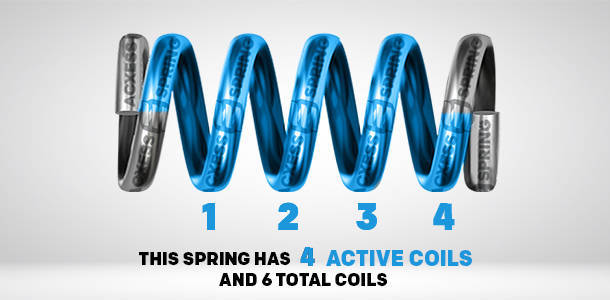
Coil Mean Diameter (CMD) – The diameter from center to center of the coil wire. Measure the diameter of the coil from wire center to wire center. If you know the coil is .5 inches thick and the outside diameter of the coil spring is 5-inches, then the Coil Mean Diameter would be 4.5-inches.
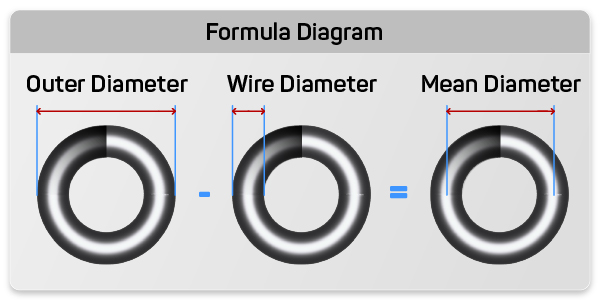
Other Articles / Resources:
Understanding Leverage on a Ford TTB Suspension
How To Calculate Motion Ratio & Wheel Rate For A Ford TTB Suspension
F-150 Coils For Your V8 Ford Ranger
Maximum Flex For The TTB With Jeep Coils
Getting The Most From Your TTB Suspension
I Have A Dual Spring Rate Lift Height Puzzle For You (Forum Discussion)
Coil Spring Rates (lb/in) & Free Lengths (Forum Discussion)
Wanted Coil Spring Measurements When Installed (Forum Discussion)
EB Coils I Think I Found The Unicorn (Forum Discussion)
Coil Springs (Forum Discussion)
